
|
🚲 What are the most bike-friendly cities in the U.S.? 🚲
We found the three most bike-friendly cities in the U.S. are Portland, Ore., San Francisco, and San Jose, Calif.
|
Most Bike-Friendly Cities, Ranked | 15 Most Bike-Friendly Cities | Top 5 Cities by Category | 10 Least Bike-Friendly Cities | Methodology | FAQ
Since the invention of the penny-farthing pedaled bicycling into mainstream fashion, cycling has been a favorite mode of transportation across the globe. However, the recent need for socially distant transportation and health-conscious community transit systems has inspired a surge in cycling.
In fact, the U.S. Census Bureau reports that cities across the U.S. saw a surge in cycling traffic after the pandemic began, prompting a bicycle shortage as many Americans found cycling to be a reprieve from at-home isolation or a socially distant solution to their commutes.
Whether you're a cycling enthusiast or a first-time pedal pusher, cycling is a great way to get a low-impact workout while also reducing your transportation costs. But if you're considering switching to a two-wheel commute — or hoping to relocate to find better biking resources — it's worth asking an important question: Which cities are the most bike-friendly in the U.S.?
To find out, we analyzed data from the U.S. Census Bureau, U.S. Department of Transportation, U.S. National Centers for Environmental Information, Walk Score, Rails-to-Trails Conservancy, Vision Zero Network, Google Trends, and Yelp.
Our weighted rankings include:
- 4x: Bikeability score, a measure of how traversable a city is by bicycle
- 4x: Percent of workers commuting to work by bicycle
- 3x: No. of shops per 100,000 people offering bicycles for purchase/bicycle repair services
- 3x: No. of shops per 100,000 people offering bike rental services
- 2x: No. of biking trails per 100,000 people
- 2x: No. of bike share docking stations per 100,000 people
- 2x: Status as a Vision Zero Community (committed to transit safety)
- 1x: Google search trends for bicycle-related terms in each metro
- -1x: No. of days per year the city experiences precipitation
- -1x: No. of days per year the city experiences unsafe air quality
Read on to find out which cities are leading the pack and which are falling behind!
Most Bike-Friendly Cities in the U.S. Stats 🚲
|
The 50 Most Bike-Friendly Cities in the U.S., Ranked
The 15 Most Bike-Friendly Cities in the U.S.

Whether it's long-standing bike-benchmarks such as Portland or lesser-known cycling scenes like Minneapolis or Salt Lake City, our top 15 cities pedal at the perfect cadence. As a group, these metros stand out because they have:
- Bikeable networks: The top 15 cities have an average bikeability score of 69 out of 100, 1.8 bike trails per 100,000 people, and a 94% higher percentage of workers commuting to work via bicycle (0.99) than the average city in our study.
- Bicycle resources: Our top 15 cities have 78% more bike share stations (4.8), 36% more bike rental shops (0.7), and 68% more bicycle shops (1.7) per 100,000 people than the average city in our study.
- Transit safety: Nearly every city in our top 15 have made a Vision Zero commitment, which means they meet various criteria that indicate a city-wide commitment to bicycle safety and transit safety in general. Those that have not made a Vision Zero commitment have still made significant investments in improving and maintaining their transit systems.
- Bicycle interest: The 15 most bike-friendly cities have fostered interest in cycling and bike-related activities, sporting an overall 52% higher average Google Trends rating across three bicycle-related search terms than the average city in our study.
1. Portland, Oregon
| 🥇 King of the Mountain Portland is a haven for cyclists, with a bikeability score of 83 out of 100 and the most bicycle shops per capita (3.5 per 100,000 residents) of any city on our list. |
In addition to numerous places to pick up or tune up your bike, the most bike-friendly city in the U.S. offers 7.7 bike share stations per 100,000 residents, meaning cycling is increasingly and consistently available to Portland residents.
It certainly helps that Portland's air is some of the cleanest in the country, as the city managed to keep pollutants below unsafe levels every day in 2021. And although Rose City might be known for its rain (receiving an average of 163 days of precipitation per year), poor weather hasn't stopped Portland cyclists. Festivals such as Pedalpalooza and the World Naked Bike Ride fill the city's calendar, along with summer events such as Sunday Parkways Rides (inspired by a weekly event in Bogotá, Colombia) or Bridge Pedal (when nearly 20,000 cyclists cross Portland's many bridges).
Not only does the city sport a busy biking schedule, but Portland has also invested in several pedestrian and bicycle safety measures to ensure not only biking culture but also that bicyclists themselves are kept alive, marking the metro as a Vision Zero community.
The city estimates that its bicycling infrastructure is worth about $60 million – the approximate cost for a single mile of urban freeway. With a bikeability score of 83 and 2% of Portland workers commuting to work by bicycle, the city has successfully made travel by bike a staple of its transportation flows.
2. San Francisco, California
| 🌁 Bay Area Bikes San Francisco has the most bike share stations of any other city in our study, with 10.8 per 100,000 residents. |
Many California cities have made the top 15, but San Francisco takes the cake. Confined to the San Francisco Peninsula, SF is dense but compact, making short trips to work or recreational activities commonplace – and perfect for traveling by bicycle.
To maintain a safe transit system for cyclists, the city has invested in several initiatives and plans and has seen significant decreases in traffic deaths and increased bike travel as a result. San Francisco's Quick Build model for improving transit corridors has also led to at least 80 miles of completed or in-progress improvements since 2014, helping to support community networks and events that center around San Francisco's biking infrastructure.
Consequently, these measures have made commuting by bike increasingly possible. The Census reports that 1.7% of workers in San Francisco travel to work by bicycle – 236% more than the average city in our study.
Today, San Franciscans can easily traverse the city by bike, with a bikeability score of 72 out of 100 and 21% more bike trails than the average city we studied (1.7 per 100,000 residents). As the city recently voted to make Golden Gate Park's JFK Drive permanently car-free, SF is sporting a great biking landscape for cyclists of all ages.
3. San Jose, California
| 🌄 Scenic Cycling The Capital of Silicon Valley is No. 2 for bike trails, with the second-most bike trails of any city in our study (4.1 per 100,000 residents). |
San Jose has continually nurtured its long-standing commitment to cycling accessibility and safety. In 2020, the city completed its 2009 Bike Plan to build out a 400-mile basic bike network – but Teal Town isn't done yet.
Local organizations such as San Jose Bike Party collaborate to share bike knowledge, coordinate group rides and plan bike-related events and activities. The San Jose Bicycle Club also won the 2020 best all-around team of Northern California and Nevada. To support and sustain this growing bike scene, the city of San Jose has followed up with the Better Bike Plan 2025, initiated in 2020 with a goal to build up a low-stress, safe biking network for all residents.
With a bikeability score of 62 and 1.5% of commuters traveling by bicycle, San Jose is certainly pedaling ahead of the pack. In addition to the plethora of ways to traverse the city on two wheels – whether it be by bike trail or bike lane – there are also plenty of ways to connect with other bikers or dial in your gear. San Jose is home to 147% more bike shops (2.5 per 100,000 residents) than the average city in our study (1 per 100,000 residents) and offers 0.7 bike rental shops per 100,000 residents for those who want to try before they buy.
4. Minneapolis, Minnesota
| 🚲 Twin Tires Minneapolis is tied with Portland for most bikeable city, with a bikeability score of 83 out of 100. Additionally, the Twin Cities ranks No. 2 for most bike sharing stations (10.7 per 100,000 residents). |
Minneapolis has long been home to a vibrant cycling community, advocating at many turns for increased bicycling infrastructure and support. Among these advocates are groups such as Our Streets Minneapolis and the Bicycle Alliance of Minnesota, championing for more traversable, safer streets and contributing to a community culture that acknowledges how bikeable and walkable cities help promote more accessible spaces, access to jobs, and more.
Move Minneapolis, a local organization that empowers employers to promote alternative commuting methods, provides links to interactive bike maps to help residents plan their commutes, and the local ABC Ramps Mobility Hub offers bicycle lockers, showers, and bike racks for commuters and other cyclists.
In addition to a Vision Zero commitment to reduce traffic deaths and improve safety measures, the city has done a great job gearing up for the 0.7% of workers who commute via bicycle every day. According to the city's website, Minneapolis is home to 16 miles of protected bikeways, 98 miles of bike lanes, and 101 miles of off-street bike trails.
5. Sacramento, California
| 🌴 Tires & Trees A 2.6x higher percentage of workers commute by bicycle (1.3%) in the City of Trees compared to the average city in our study (0.5%). |
From popular routes such as the American River Bike Trail to the City College Pedestrian and Bicycle Bridge, Sacramento has grown to accommodate both new and experienced cyclists. Home to 2.2 bike trails and 1.5 bike shops per 100,000 residents, Sacramento has invested in numerous projects and infrastructure upgrades that make more of the city accessible to people-powered modes of transportation.
In addition to city-funded programs, local organizations and businesses such as The Sacramento Bicycle Kitchen have continually supported Sacramento cycling culture, offering courses and repair services and hosting events.
The cycling community in Sacramento also shows up – Sacramento has a 37% higher average Google Trends rating across three different bicycle-related search terms than the average city in our study.
6. Denver, Colorado
| 💯 The Cycling Scene Denver is home to 106% more bike shops (2.1) and nearly 100% more bike trails (3.4) per 100,000 people than the average city in our study. |
Denver has long been considered a cycling haunt for recreational bicyclists, and its transit network has slowly risen to meet the urban cycling scene. After shutting down its bike share system B-cycle in 2020, the Mile High City reintroduced e-bikes in 2021 and has also committed to building safer and more accessible bikeways across the city through its Denver Moves: Bicycles program.
Since the program's inception in 2019, the city has completed more than half of its goal to install 125 new miles of bike lanes by 2024. As a result, The Denver Post reports that 73% of Denver homes are now situated within a quarter mile of a protected bike lane.
Years of support for cycling safety and accessible micro-mobility in Denver are manifest in its current bikeability score of 72 – 32% higher than the average city in our study. Additionally, the Census reports that 0.8% of workers in Denver gear up to bike to work every day. This is great news for Denver's biking advocates, such as the Bike Denver Initiative and the Denver Bicycle Lobby, which have fought tirelessly for comprehensive transit support for cyclists.
7. Washington, D.C.
| 🛣️ Sharing the Road Washington, D.C., is the home of the nation's first experiment in bike share systems (SmartBike DC). Today, America's capital has 9.98 bike share stations per 100,000 residents – 272% more than the average city in our study (2.7). |
Although D.C.'s Capital Bikeshare usurped SmartBike DC in 2010, the city has been a staging ground for many bicycle initiatives. D.C. may be tied with Denver for the share of commuters who travel by bike (0.8%), but with a bikeability score of 70 out of 100, our nation's capital boasts plenty of cycling infrastructure to compete with.
In a city where the Census estimates 0.8% of workers commute by bike, increased infrastructure for people-powered transit is crucial. Since 2001, the District Department of Transportation (DDOT) has built over 100 miles of bike lanes and, as of late 2021, has built out 24 miles of protected bike lanes across the city. Per an ambitious 2020 plan, the district has committed to building 20 miles of additional protected bike lanes by 2024.
With help from organizations such as the Washington Area Bicyclist Association, a group that hosts workshops, trainings, and neighborhood rides, the D.C. area is building safer areas for cyclists and pedestrians. This way, events such as DC Bike Ride (advertised as the only car-free bike ride in the city) can continue with support from people and infrastructure alike.
8. Boston, Massachusetts
| 🏙️ Beantown Is Biketown With just four days of poor air quality in 2021 and 1% of workers commuting to work by bike, Beantown has a great atmosphere for cyclists. |
Situated in the No. 1 state for bicycle-friendliness, Boston has definitely been pedaling people-powered transit over the last decade. Since 2009, Boston has added a bike share network known as Bluebikes, promoted a more comprehensive transit system through the Go Boston 2030 initiative, launched a Vision Zero action plan in 2016, and committed to building neighborhood Slow Streets and 15 miles of protected bike lanes in 2018.
These initiatives are certainly needed, as the city found that, in just one day alone, on Sept. 29, 2021, Massachusetts Avenue Bridge saw a whopping 4,232 bicycles. Now, thanks to advocacy groups such as MassBike and the Boston Cyclists Union (BCU), more residents have access to growing trail systems that build on Boston's 1.6 bike trails per 100,000 residents and bicycle resources such as the free bike repair clinics hosted at summer markets by the BCU.
With 8.2 bike share stations per 100,000 residents and free passes for qualifying essential workers, locals can take Bluebikes through Boston's growing bike lane network as the city continues expanding through many ongoing bike corridor projects.
9. Salt Lake City, Utah
| 🚲 Salt Lake Cycling SLC is a great place for bicyclists, sporting a bikeability score of 74 and ranking No. 2 for number of bike shops per 100,000 residents (2.7). |
The 0.6% of workers who commute by bicycle in the City of Saints can travel with relative ease based on the city's bikeability score – 36% higher than the average metro in our study. But not only can residents pedal freely, bikes are also in abundance in Utah's capital. In addition to the city's high bike shop count, Salt Lake City is home to 3.7 bike share stations per 100,000 residents. GREENbike, Salt Lake City's non-profit bike share program, started in 2013 and has since provided affordable access to transit alternatives while offsetting more than 5.8 million pounds of CO2 emissions.
And going green seems to be Salt Lake City's forté: Residents of SLC have access to 82% more bike trails per 100,000 people (3.1) than the average city in our study (1.7) and ranked No. 1 in searches for "bike trails," meaning locals are often searching for bike trails, according to Google Trends.
Although the city has not yet implemented a Vision Zero program, SLC has worked to build up bicycling infrastructure and community with help from local advocates and organizations such as Bike Utah, Sweet Streets, and The Bicycle Collective and is situated in the 10th-most bike-friendly state in America. In 2015, the city introduced the Pedestrian and Bicycle Master Plan and, to support the use of people-powered transit networks, the city's website offers comprehensive bikeways maps and guides on where and how to traverse the city on two wheels.
10. Seattle, Washington
| 💼 Working Wheels The percentage of workers commuting via bicycle in Seattle (1%) is twice as high as the average metro in our study (0.5%). |
Despite its nickname "Rain City" (and the 156 days of precipitation the metro receives on average annually), we found that Seattle is wheelie bike-friendly! Emerald City has grown significantly in the past decade and became the fastest-growing major metro in the 2010s with a 23.8% population growth rate. With such rapid expansion typically comes some growing pains, but Seattle rose to the challenge.
The city introduced the 2021 Bicycle Master Plan to accommodate growth by focusing on nurturing bicycle culture and infrastructure throughout the city. In tandem with Seattle's efforts to support its cycling scene, Washington has successfully passed the largest funding package for cycling education and infrastructure in the state's history, allotting $1.3 billion in funding for people-powered transit systems.
Naturally, Seattle ranks in the top 10 for both the number of bike shops per 100,000 residents (1.7) and bikeability (scoring 71). And with a clear Vision Zero commitment to tackle unsafe transit zones and clean air (only three days of unsafe or worse air quality in 2021), Emerald City has earned its place on the yellow-brick road of bike-friendly cities in the U.S.
11. New York City, New York
| 🗽 Liberated Lanes NYC is continually investing in cycling and pedestrian infrastructure while offering 8.1 bike share stations per 100,000 residents, making bicycling increasingly accessible to New Yorkers. |
New York has long been a city of cyclists. To meet the city's rising demand for safer, more traversable bikeways, the New York Department of Transportation (NYC DOT) has set benchmarks for 30 new miles of bike lanes and 400 redesigned intersections in 2022. This comes on the heels of multiple past initiatives, including a 2014 Vision Zero commitment and a 2019 cycling plan (Green Wave) that increased bike lane mileage and general transit safety.
This is great news for the 0.7% of NYC workers who commute by bicycle and is bound to bump up the city's already high bikeability score of 69. But the Big Apple isn't done yet.
Mayor Eric Adams recently announced a $900 million investment in traffic safety that would include five additional bike lanes by the end of 2023 and other physical infrastructure upgrades to improve traffic safety for all travelers. Locals interested in keeping up with the city's improvements can check out the NYC DOT's website for updates on current bike route projects or check in with the NYC Bicycling Coalition to support street safety and accessibility.
12. New Orleans, Louisiana
| 💯 The Bike Easy New Orleans makes bike access a priority, with the most bike rental shops per 100,000 residents (1.6) of any city in our study. |
In addition to lots of rental options, NOLA is home to 1.5 bike shops per 100,000 people and experienced just four days of unsafe air quality in 2021, making it a great metro for cycling enthusiasts and amateur peddlers alike.
With support from advocacy groups such as Bike Easy, NOLA has gradually built up bicycle infrastructure over the last few years. Beginning with a series of community input meetings in April 2019, NOLA's Moving New Orleans Bikes program aims to construct a safer and more connected bikeway network across the city.
Since its inception, many bike corridor projects in New Orleans have been completed, with more on the way. And according to Bike Easy's advocacy page, the project is projected to implement more than 600 miles of new routes across New Orleans – a huge win for the 1% of New Orleans workers who commute via bicycle.
13. Chicago, Illinois
| 💨 Windy & Wheely Windy City is home to 163% more bike share stations per 100,000 residents (7.1) than the average city in our study (2.7). |
With a bikeability score of 72 out of 100, it's clear that The City That Works has been hard at work. Chicago has continually geared up to improve its cycling infrastructure, whether it be new-and-improved bike lanes or improving the affordability of its bike share system.
According to the Chicago Department of Transportation (CDOT), the city plans to add to the already-existing 350+ miles of on- and off-street bikeways through its Chicago Works Capital Plan. The 5-year investment plan includes 12 miles of new protected bike lanes, which will help to improve safety for the 0.6% of Chicago workers who bike to work regularly.
In addition to government bodies, local advocacy groups such as the Active Transportation Alliance work to further the implementation of cycling and pedestrian network initiatives that make Chicago streets safer and more traversable by bike or on foot. With recent motions to provide more cycling resources to locals by Chicago Transportation Commissioner Gia Biagi – who estimates the city will have added 125 miles of new bikeways from 2020 through 2022 – Chicago cyclists can look forward to more places to pedal in the near future.
14. San Diego, California
| ✨ Am-air-ica's Finest City San Diego experiences 64% fewer days of precipitation annually than the average city in our study and had just two days of unsafe air quality in 2021, making America's Finest City a great place for bicyclists. |
Since the implementation of the San Diego Association of Governments (SANDAG) 2010's Riding to 2050: San Diego Regional Bicycle Plan, construction has been slow-moving, but the city is still making strides. The plan calls for 227.8 protected bike lanes by 2050 and has been propelled forward by a $200 million investment in the Regional Bike Plan Early Action Program (EAP) geared toward building out San Diego's existing bike network and funding bike and pedestrian projects.
With help from local advocates such as Bike SD and the San Diego County Bicycle Coalition, the city has grown more bike-friendly over the last few years. In fact, San Diego officially committed to Vizion Zero in 2015 – great news for both the 0.6% of San Diegans who commute by bike and also recreational cyclists.
Infrastructural improvements such as the 19 miles of new bike lanes SANDAG has scheduled to break ground in 2022 will also be a boon to local shops. Home to 1.8 bike shops and 1.3 bike rental shops per 100,000 residents, San Diego will continue to be a hub for cyclists.
15. Tampa, Florida
| ⚙️ Gears & Guava Locals in The Big Guava have biking passion: Tampa ranks No. 1 in Google searches for the term "bicycle." |
If cycling passion wasn't enough, Tampa is ranked No. 1 in the nation for the number of bike-friendly businesses, per the League of American Bicyclists. With just two days of unsafe or worse air quality in 2021 and 5.4 bike share stations per 100,000 residents, Tampa is pushing ahead as a top city for cycling.
Home to 154 miles of bikeways, including 137 miles of on-street bike lanes, the city has worked with bicycle advocacy groups such as Bike/Walk Tampa Bay to increase accessibility and safety for people-powered transit networks. Fortunately for the 0.6% of Tampa workers who commute by bicycle, part of the city's commitment to transit safety includes a 2019 Vision Zero plan, which outlines methods to increase the use of active transportation modes.
In addition to bike share stations, bikeable infrastructure, and bike-friendly businesses, the Florida Department of Transportation financed several bicycle repair and maintenance stations across Tampa in 2019. With both infrastructural and community investments, Tampa is easily one of America's most bike-friendly cities.
Most (and Least) Bike-Friendly Cities by Category
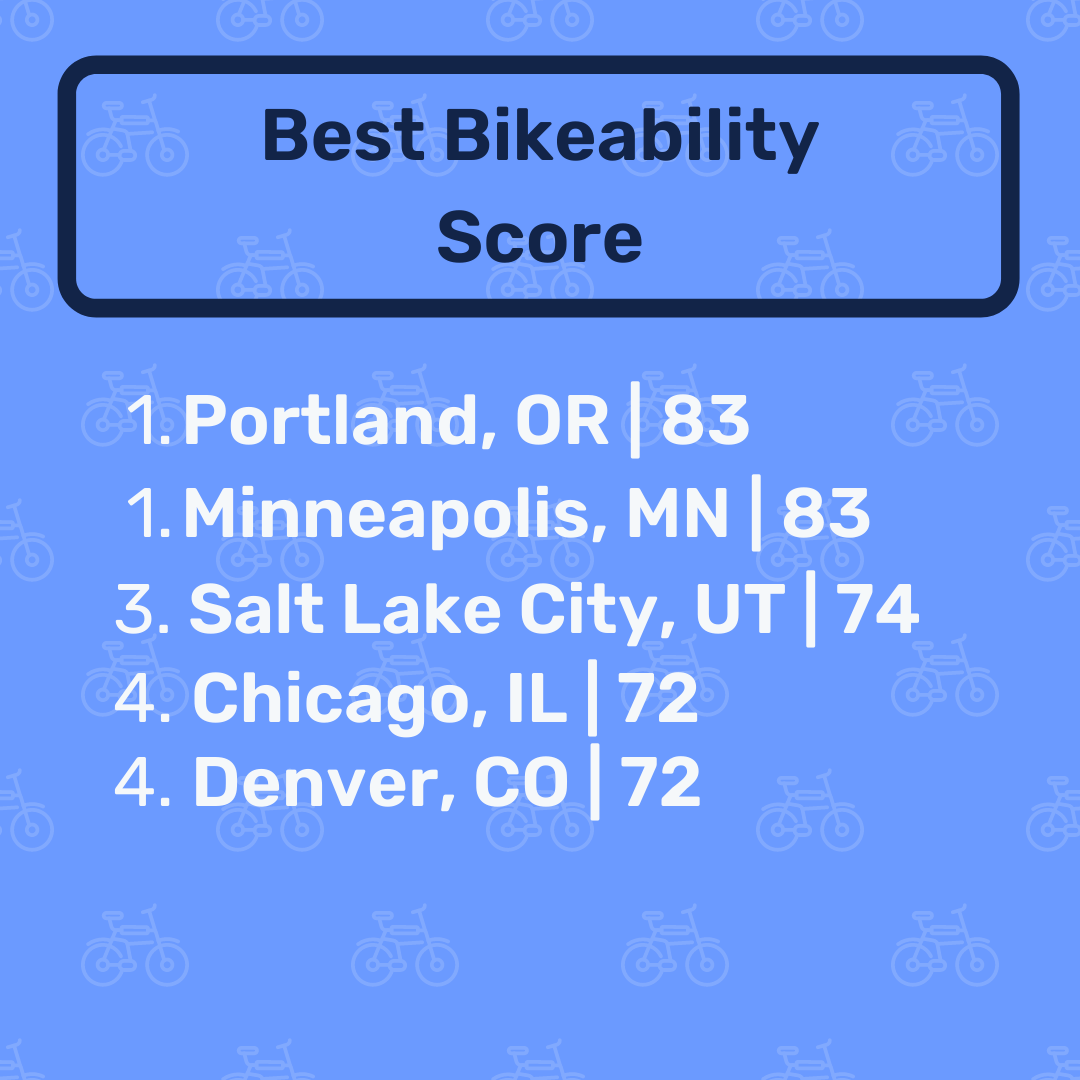 |
 |
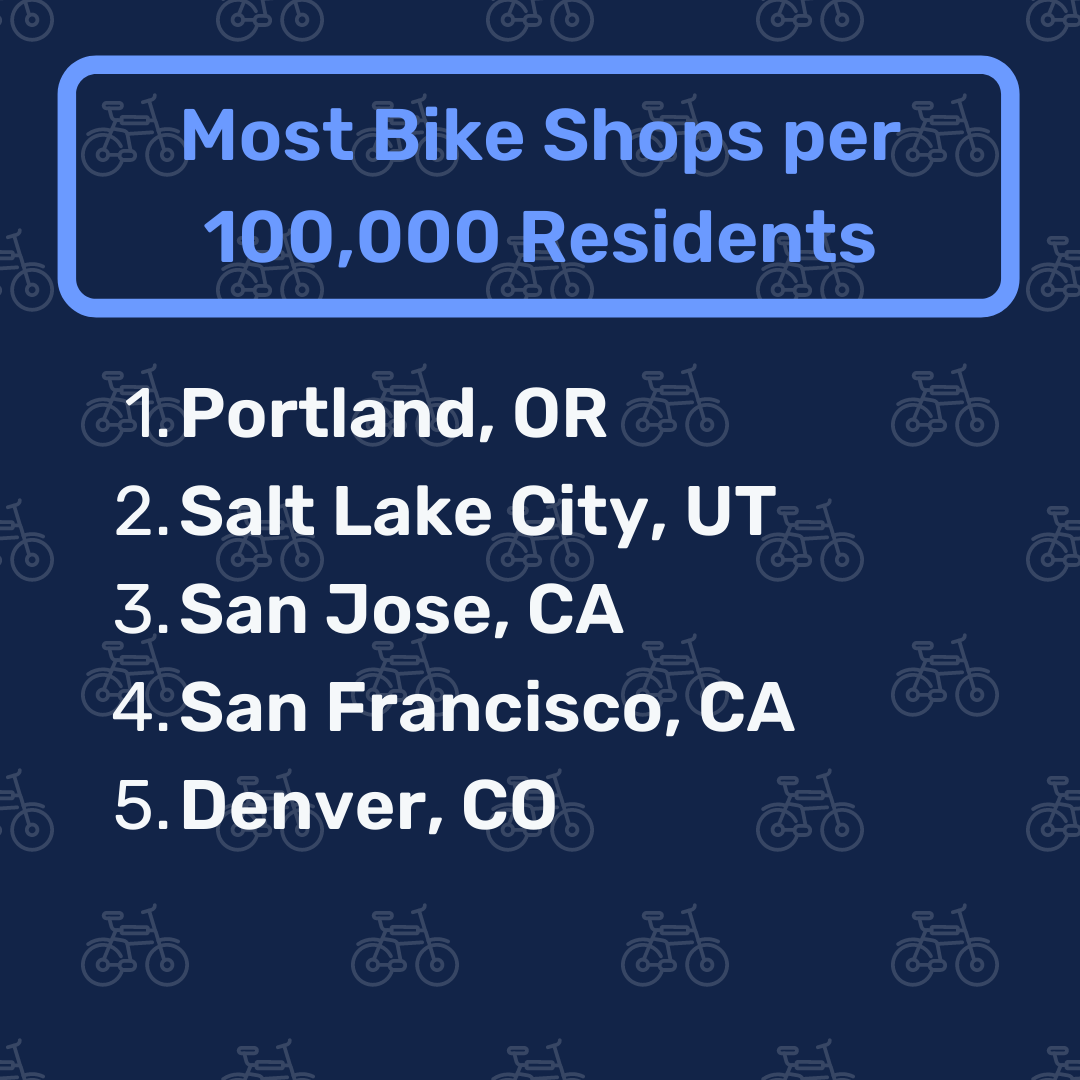 |
 |
 |
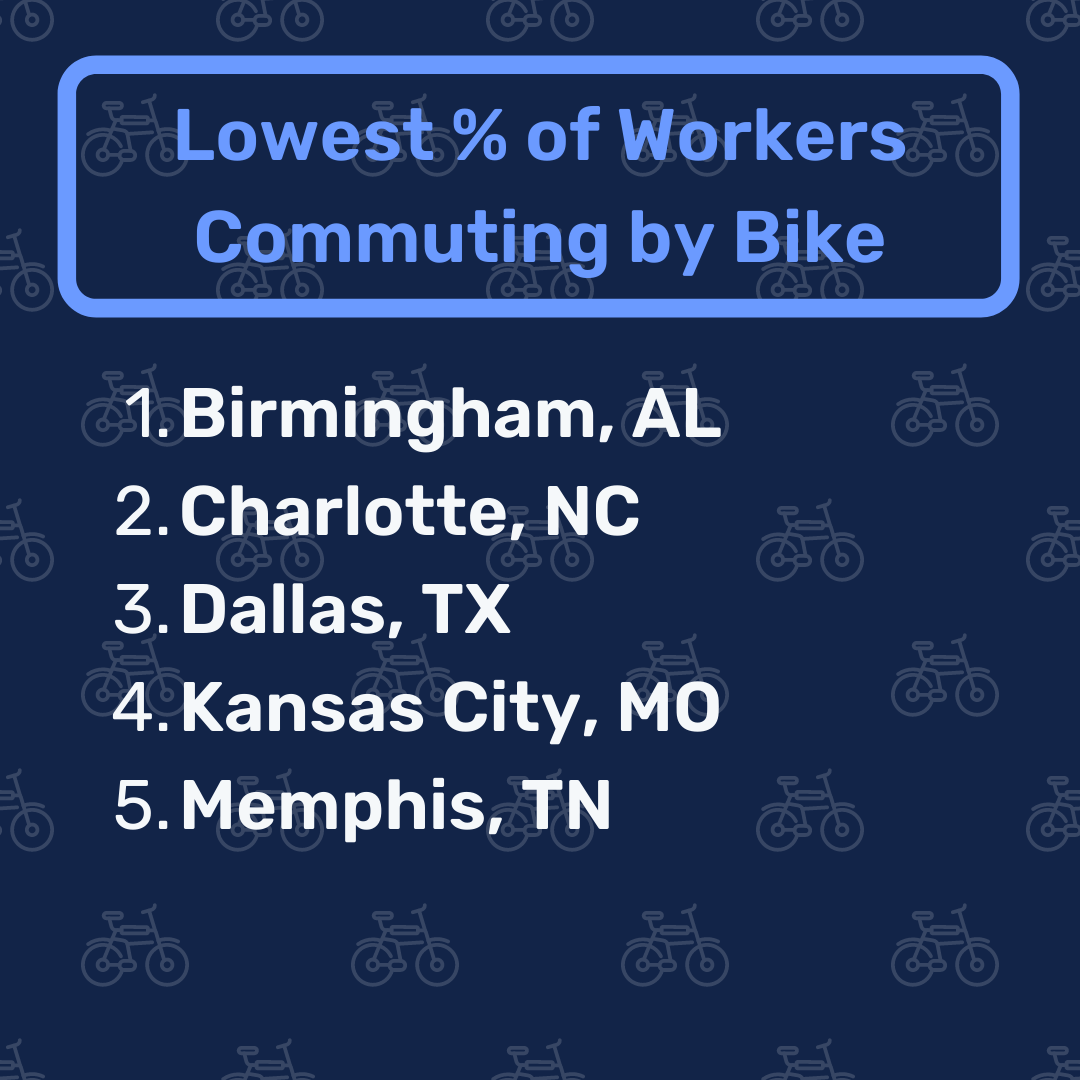 |
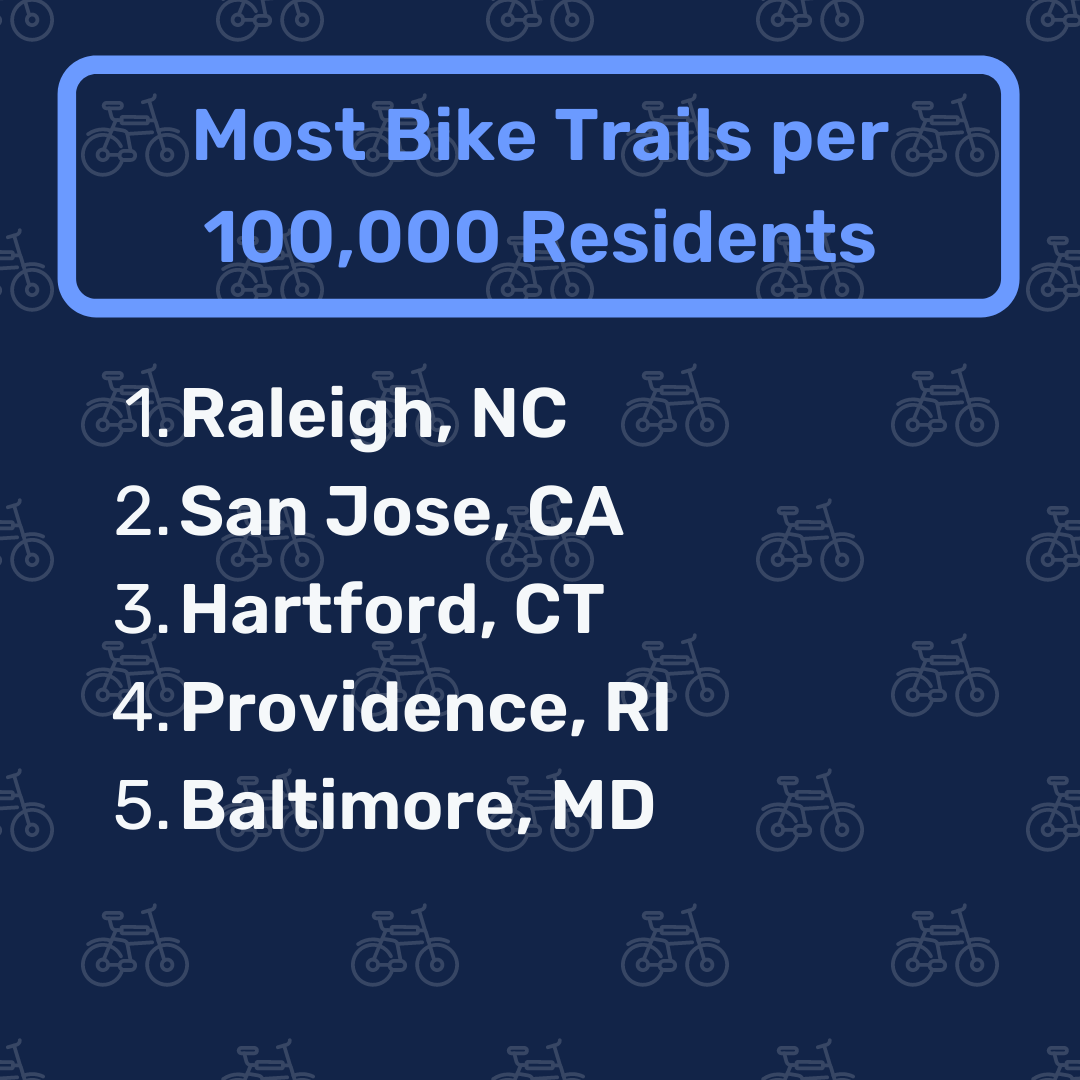 |
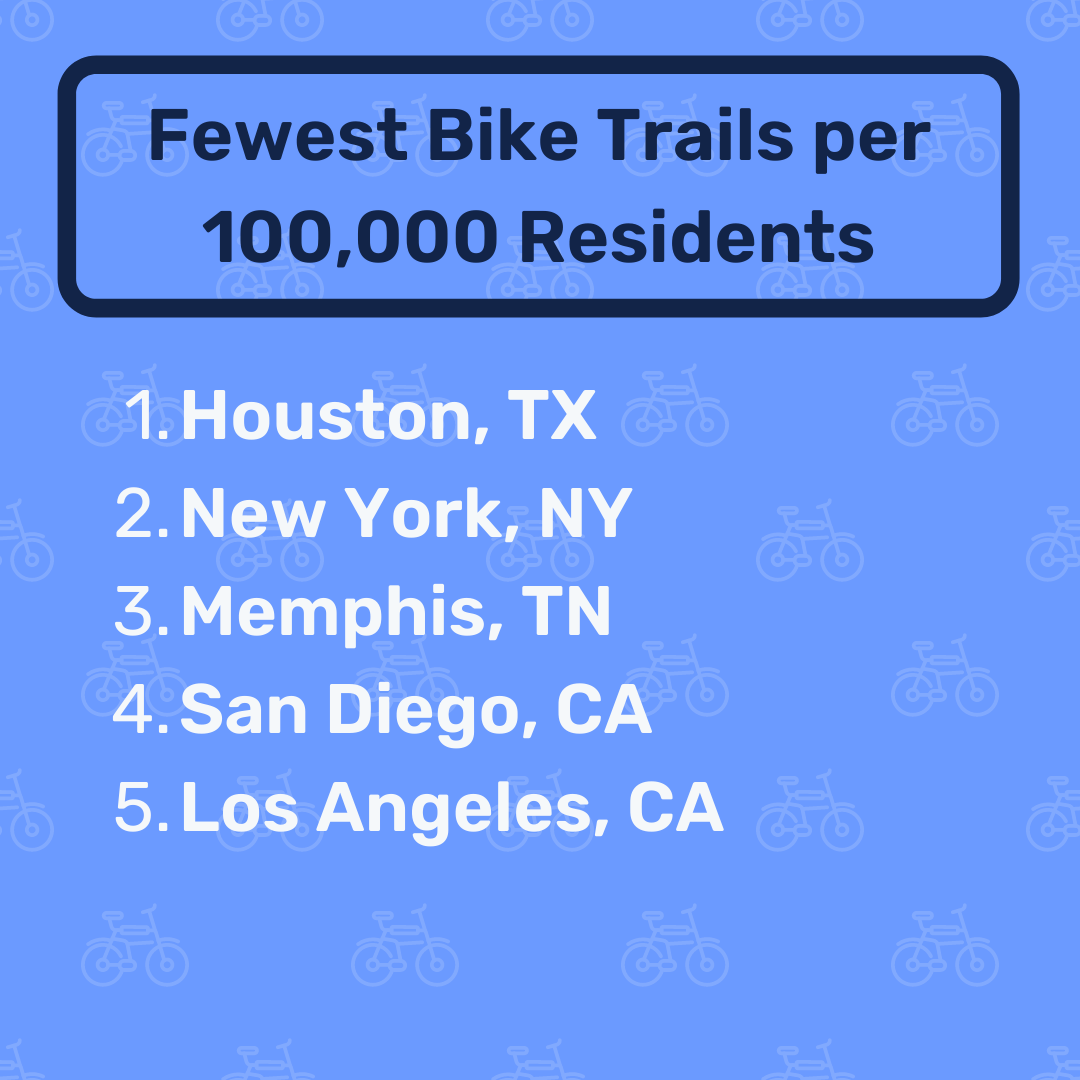 |
The Least Bike-Friendly Cities in the U.S. 🚳
Not all metros can handle themselves when it comes to bicycle-friendliness. Of the 50 most populous cities, these 10 wiped out:
- Dallas, TX
- Birmingham, AL
- Atlanta, GA
- Nashville, TN
- Riverside, CA
- Memphis, TN
- Oklahoma City, OK
- Las Vegas, NV
- Detroit, MI
- St. Louis, MO
The 10 least bike-friendly cities on our list offer less access to cycling resources and less bikeable cityscapes.
Altogether, the bottom 10 cities have an average bikeability score of 44 out of 100. Compared to an average of 69 across the top 15 cities, that's a 36% lower score, indicating that cyclists will have a harder time traversing these 10 metros.
As a result, an average of just 0.2% of workers commute via bicycle in the bottom 10 cities. Additionally, our bottom 10 cities have an average of just 0.6 bike shops per 100,000 people – 45% less than the average city in our study (1 per 100,000 residents).
In last place, or what some cyclists may term lanterne rouge, is Dallas. This Texas metro falls far behind, with 75% fewer bike shops per 100,000 people (0.3) than the average city in our study (1). Even more, just 0.1% of workers commute via bicycle in Dallas. Compared to the average city in our study, where 0.5% of workers commute via bike, that's 80% less.
Dallas also has zero bike share stations, making travel by bike less accessible than in other metros. To offset the lack of widespread bike share options, there are few bike rental shops – just 0.09 per 100,000 residents and 81% fewer than the average city in our study.
Methodology
Anytime Estimate compared the 50 most populous U.S. metro areas across a number of metrics, listed below. Each metric was normalized and then graded on a 100-point scale. The combined weighted average of the scores determined the “bike city” score upon which the final ranking was based.
In cases where data sets included only cities or other statistical areas, the city data was combined into the overall metro in which the city belonged to the extent of the available data. In cases where data sets included only counties, county data was crosswalked with metropolitan data. In cases where data sets included only states, the state where the largest portion of the metro is located was used.
The metrics used are as follows:
- Bikeability score: A measure of how traversable a city is by bicycle
- No. of shops per 100,000 people offering bicycles for purchase or bicycle repair services
- No. of shops per 100,000 people offering bike rental services
- No. of biking trails per 100,000 people
- No. of days per year the city experiences precipitation
- Percent of workers commuting to work by bicycle
- No. of bike share docking stations per 100,000 people
- Status as a Vision Zero Community (committed to bicycle safety)
- Google search trends for bicycle-related terms in each metro
- No. of days out of 2021 the city experienced unsafe air quality
About Anytime Estimate
Stay on top of your money, around the clock. Since 2009, Anytime Estimate's straightforward calculators and expert articles have simplified mortgages, refinancing, and other real estate costs — fast. In 2021, Anytime Estimate was acquired by Clever Real Estate, a free agent-matching service that has helped consumers save more than $82 million on real estate fees. Research by Anytime Estimate's Data Center has been cited by The New York Times, CNBC, MarketWatch, NPR, Apartment Therapy, Yahoo Finance, Black Enterprise, and more.
More Research/Related Articles
Frequently Asked Questions
What are the most bike-friendly cities in the U.S.?"
Portland is America's most bike-friendly city, followed by San Francisco and San Jose. When it comes to metros that favor cyclists, the West is best! Read more about the most bike-friendly cities in the U.S.
Which city is not considered a top U.S. cycling city?
Of the 50 most populous cities in America, Dallas is the worst city for bicyclists. Dallas has a bikeability score of just 49 out of 100, indicating that much of D-Town is not easy to traverse by bike. Learn more about the best and worst cities for cyclists.
Which metro has the best bikeability score?
Of the 50 most populous cities in America, Portland, Ore., and Minneapolis are tied for most bikeable city, with a score of 83 out of 100. Read more about the most bike-friendly cities in the U.S.

